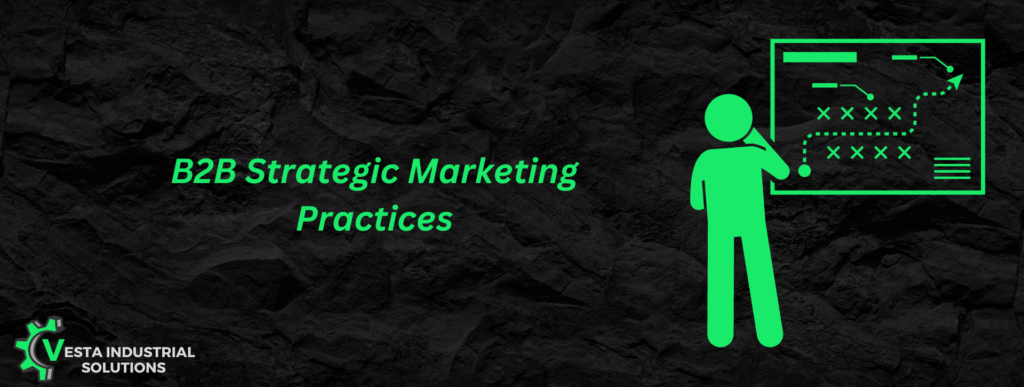There are 7 elements to help formulate a strategy that will help driving your marketing department of your company to success:
- Positioning
- Website Foundation
- Technology Stack
- Content Strategy
- Demand Generation
- Pipeline Management
- Data Analysis
In the dynamic landscape of B2B businesses, the success of your marketing strategy lies in the adept handling of core elements. Let’s delve into seven pivotal components that can drive your business toward triumph.
1. Positioning: Shaping Perceptions for Impactful Reach
Positioning is the cornerstone of effective marketing for B2B enterprises. Start by meticulously defining your ideal B2B customer at both the organizational and individual levels. Identify commonalities among your top customers – their size, location, purchasing patterns, and the triggers prompting their buying journey. This initial understanding sets the stage for the next crucial step: identifying key individuals within these organizations who influence the buying process. Conducting customer interviews further refines your positioning language, ensuring it resonates authentically with your audience.
Crafting Your Positioning Language:
Once your ideal customer profile is established, the next step involves crafting a compelling positioning language, encapsulating your value proposition. Clearly articulate who you help and how, outlining your ideal customer profile, competitive alternatives, the problems your customers face, your unique attributes, and the genuine value you offer. This messaging becomes the guiding light for all your marketing and sales communications, differentiating you in a crowded market.
2. Website Foundation: Building a Robust Online Presence
Your website serves as the online face of your B2B business, making a strong foundation crucial. Six essential building blocks include:
Content Management System (CMS): Opt for a flexible CMS like WordPress for seamless content updates.
Learning Center: A dedicated space for resourceful content addressing customer problems and goals.
Lead Generation Infrastructure: Develop prebuilt components for converting anonymous visitors into leads.
Lead Management Software Integration: Ensure seamless integration between your website and CRM and marketing automation software.
On-Page SEO Essentials: Implement on-site SEO practices, incorporating target keywords strategically.
Responsive Design: Prioritize mobile-friendly design for an optimal user experience.
Continuously improving your website with these essentials ensures it remains a valuable asset for attracting and retaining B2B leads.
3. Technology Stack: The Pillars of Marketing Efficiency
In the realm of marketing technology, three essential components form the bedrock of efficiency:
CRM (Customer Relationship Management): Central to organizing sales efforts and optimizing team efficiency.
Marketing Automation: Facilitates automated and measurable marketing activities.
Web Analytics: Leverage tools like Google Analytics for in-depth website data analysis.
These components synergize to enhance your B2B marketing strategy’s effectiveness, providing insights, automation, and tracking for informed decision-making.
4. Content Strategy: Crafting Value-Rich Narratives for B2B Audiences
In the B2B realm, content strategy is not just about what you say but how strategically you say it. It involves creating and disseminating valuable, relevant, and consistent content to engage and retain your B2B audience. Unlike B2C, B2B buyers embark on an intensive, information-gathering process throughout their buying journey.
Roles of Content:
Truly impactful content directly addresses the pain points, goals, and questions of your B2B audience. Whether it’s through articles, buyer’s guides, case studies, videos, webinars, or podcasts, your content plays a crucial role in every stage of the marketing and sales process. It helps generate awareness, answers common questions, establishes credibility, converts website visitors into leads, and nurtures leads in the background.
5. Demand Generation: Strategies for B2B Growth
Having laid the groundwork with positioning, website foundation, technology stack, and content strategy, the focus shifts to demand generation. This involves creating awareness and engagement among your B2B audience through organic, outbound, and paid media channels.
Strategies:
Organic Channels: Leverage platforms you own, such as social media pages and blogs, to establish thought leadership and improve search engine rankings.
Outbound Channels: Directly target ideal customers with well-crafted content through email sequences, timed calls, and direct mail.
Paid Media Channels: Explore platforms like LinkedIn, Facebook, or Google Ads for targeted outreach to your B2B audience at scale.
Combining organic, outbound, and paid media channels forms a comprehensive approach for effective demand generation in the B2B sphere.
6. Pipeline Management: Synchronizing Sales and Marketing Efforts
Pipeline management is not just about generating leads; it’s about what happens after. Divided into sales enablement and lead nurturing, this element ensures optimal handling of generated leads.
Sales Enablement:
Equip your sales team with efficient processes, valuable data, and relevant content to manage the sales pipeline effectively. This involves designing methodologies, utilizing lead intelligence, and incorporating content in sales communications.
Lead Nurturing:
As your pipeline fills up, lead nurturing becomes paramount. It’s the gradual process of establishing a trusted advisor position, creating consistent touchpoints with leads, and remaining the preferred choice during buying decisions.
7. Data Analytics: Driving Continuous Improvement
In today’s data-driven landscape, measuring marketing results is about more than impressions. Regular Marketing-Sales Alignment Meetings, utilizing tools like Google Analytics, help interpret data, uncover insights, and guide continuous improvement in your B2B business development strategies.

